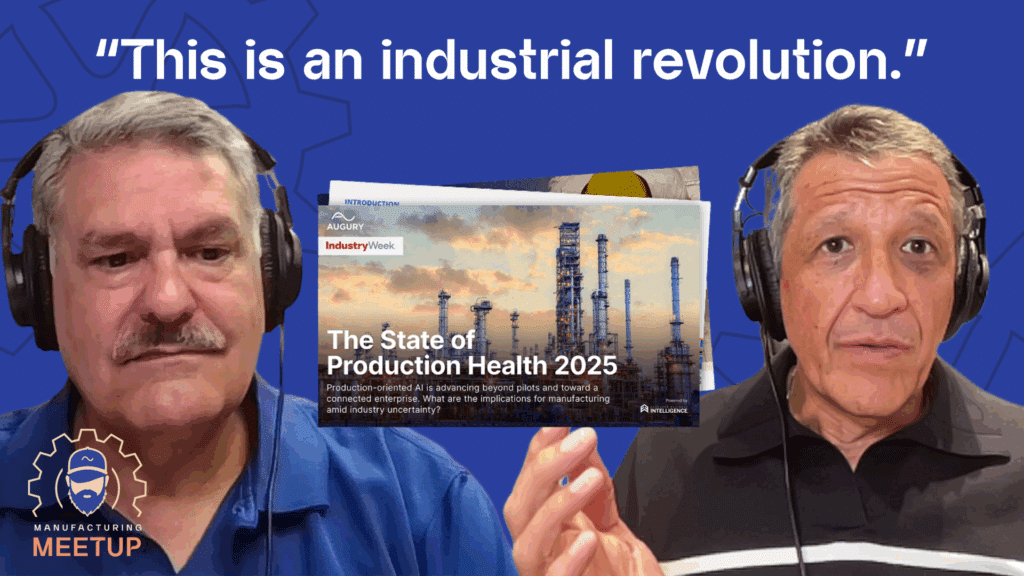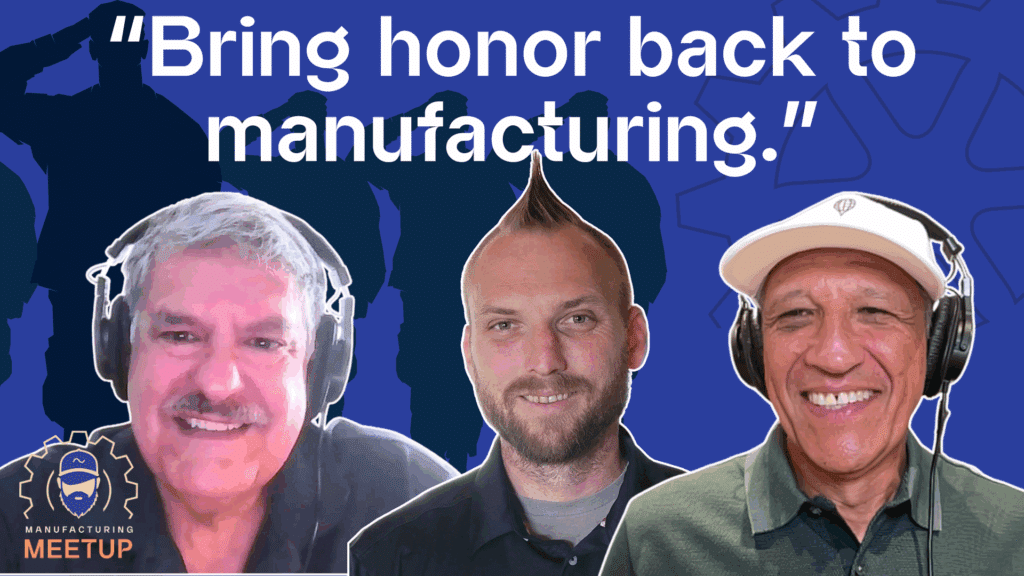Surviving Tariff Chaos: Manufacturing Strategies That Actually Work
Tariffs are creating waves of uncertainty across manufacturing and supply chains – but Ed and Alvaro have experience navigating similar storms. In this episode, they break down practical approaches to navigate tariff challenges without the political drama.
The guys share battle-tested insights from their combined decades of manufacturing experience, focusing on what you can actually control: your people, operations, and strategic planning. From keeping your team focused during uncertainty to leveraging AI-powered operational excellence and making smart portfolio decisions, this episode delivers actionable takeaways you can implement right away.
Ed shares a shocking example of how tiny production adjustments can save $300,000 annually, while Alvaro explains how new technology makes previously impossible planning approaches achievable. Whether you’re worried about reshoring decisions or keeping your shop floor productive during turbulent times, this episode provides the manufacturing wisdom you need.
As they remind us: “The barbarians are always at the gate” – but with the right approach, your manufacturing operation can thrive through any challenge. Keep calm and carry on!
To keep the conversation going:
Email us: mmu@augury.com
Find us on The Endpoint: endpoint.augury.com
Download the full podcast here:
Apple
Spotify
Amazon Music
iHeart Radio
YouTube Music (formerly Google Play)
Full Transcript
Ed Ballina:
Hello, manufacturing meetup friends. We are here again to talk to you. Hi, my name is Ed Ballina.
Alvaro Cuba:
Hello guys, Alvaro Cuba here. We have a very interesting episode today. Guess what? Tariffs. Everyone is talking about tariffs. yeah, big topic. It’s affecting the entire end-to-end supply chain, creating uncertainty across the board. So we thought, we have to give it a…try on this and provide some ideas and suggestions how to tackle this situation.
Ed Ballina:
Yeah, no, absolutely. This I mean, this impacts every aspect of manufacturing operations from trucks coming in to parts to materials, et cetera. I I would tell this, this can have an even bigger impact than COVID did as crazy as that may sound. So today we’re not talking politics. We aren’t talking necessarily those perspectives. We just want to focus on what is it that we can provide you with as ideas to help ameliorate this and get through the storm. So what are the actions that you can take? Because at the end of the day, there is one thing we control. We can control our own destiny. So let’s focus on the things we can control. The world will go all over the place. so anyway, with the theme of control what you can control, welcome to our Manufacturing Meetup podcast. The show where we kick back on our downtime, we talk about our experiences on the shop floor, and we get to share all kinds of great store stories. So, welcome.
Ed Ballina:
Awesome. So we’re going to break this up into a couple of topics. And as you may have noticed from our podcasts, Alvaro and I place a huge emphasis on people and culture. To be honest, I’ll speak for myself. It’s what’s allowed me to have tremendous opportunities in business is by making people first and foremost in my agenda. So let’s start with people first. As leaders, the most important thing that you can provide for your facility and your plant in a situation like this is to be a calming influence. You are the cheerleader. You’re out the head of the business here. If they see you panicked, if they see you stressed or nervous, that gets translated to a shop floor tenfold. Because let’s face it, there’s a lot going on, folks. People are worried about their jobs. People are worried about their retirements. They see a lot of fluctuation in the stock market.
You know, you’re worried about that and you go clear with jamming in the line. And before you realize it, you did not properly like that equipment. Now you lost the finger. That is so safety. Personal safety is our biggest gift that we can give our employees. So focus on folks. Let them know that we’re going to get through this together. OK, we’ve been through a lot of rain. We went through COVID folks, right? We can make it through this, but it’s important to keep your focus on the work and more important than anything, be safe. You’re engaging with dangerous equipment that can seriously hurt you. And then ask for help. Okay, so if all of a sudden these parts that we were supposed to get in from, let’s say, from Europe are now delayed by several months because of this, what are we gonna do? Help us. A lot of the answers lie on that shop floor.
Alvaro Cuba:
Yeah, and this is, as Ed’s mentioning, is bigger. It goes much wider than the manufacturing floor. So it’s uncertainty on suppliers, uncertainty on the plant, uncertainty on customers in the supply chain. So everyone is there and the best we can drive this is with leadership. And helping our folks on the shop floor. Today, have, there is so much opportunity with technology in, so you have the Twin Towers that help you to train the people or to model what’s going to happen. have ChatGPT, everyone is using ChatGPT. Well, there is the version AI Coach that you can use for your folks in your line, in your…operations. So they can feel supported. They can ask quick questions. There is monitors or mobiles that allow you to do senior mentoring junior and help them. No. And also these days you have a lot of insights and analytics that comes in the monitors in the plants. So all those ways are ways you can help your folks. Keep them focused and never let a crisis go unused. So this is a good opportunity to think in our folks and to work with them.
Ed Ballina:
Absolutely. We have to get creative, right? But as I was sharing with Alvaro, I’ve been in business now for two and a half years, the one thing I’ve learned is the barbarians are always at the gate, folks. Even with my tiny little business, today it’s supplier having an issue with, tomorrow it’s my customers are not growing as fast or transportation is problem. The barbarians are always at the gate. And that is true of almost any manufacturing enterprise that I’ve been involved with throughout my career. You have different challenges, but rarely do I remember a year where it was everything worked out perfectly and we had delivered great performance and everybody was happy and there was easy sailing. No sir. yeah.
Alvaro Cuba:
Non-existent in supply chain. Sorry to say guys, but you corroborate with your own experience. One thing, remember though, it’s 2018-19, we had some similar thing. Tariffs in China, in Canada, Mexico, Europe, and then negotiations and all that. we have experience also, we can tap into that experience.
Ed Ballina:
This is where the rubber meets the road.
Alvaro Cuba:
As Ed was saying, we wanted to talk to you about three topics, one with people, which we always start with it. And then the other is what is the impact and what we can do on the tactical operational. And then we’ll address the same thing from a strategic perspective. So from an operational tactical, this impacts the three, cost, cash and service. And we need to think about whatever we do, it has to have benefits on the tree. The obvious one and comes immediately to mind is, my God, I have to save cost. It’s always what management tell us in the plants. So costs are going up, prices are going up.
Guys, you need productivity to offset as much as possible. But it’s not the end, no? You need to think in service because people is going to be buying different things depending on the prices. Competition is going to be doing things. So we need also to provide product on the shelf. And whatever we can do in the plants to reduce cash is cash that the company can use it in other place.
So when we talk about these operational problems, the first thing that comes is operational excellence. Every pillar in operational excellence address the three of them and people, because it’s the idea TPM, lean, five FAS, whatever you want, it will address that. The good news is now with AI, with technology, we can, it’s like a reloaded version. The operational excellence. No, because with that you can implement much faster. In three months you can go from understanding, implementing, getting results. And you don’t need CAPEX, you only need OPEX. So it’s quick. Examples, quality. Just first time, imagine if you can improve your quality and go just right the first time. The impacting cost, no waste, no recycling or reprocessing, your lines become more predictable, then your service improves, then you can reduce inventories. So it hits. And the same with machine health or process health. All that combined is something that is going to give you capacity you will need if you decide to reshore, efficiency for cost, agility for inventory, and predictability for service.
Ed Ballina:
All real target areas, right? One takeaway from what Alvaro just said is if you work on OPEX, right, there are so many benefits aside from just the financial, whether it’s less to landfill, less employee engagement with equipment, which we know it’s a numbers game, right, when it comes to injuries. The less person/machine interfaces that you have, the lower the risk of injury.
But we may have to make some tough decisions here when it comes to our portfolio. I saw this happen during COVID. We couldn’t get all the materials that we needed in time and all that. So a lot of the consumer packaged good companies, they significantly cut their SKU profile. They didn’t offer every choice to everybody. And believe it or not, that threw off tremendous amounts of productivity. However, as soon as we were over COVID and then we had a little more capacity, and our pricing started dropping, they were like, we need more SKUs. we threw all the SKUs back on, which had a complexity in cost.
Well, to Alvaro’s point, when it comes to point time where, you you got to bat down the hatches, those are the places to go and get real efficiency out. And frankly, you communicate that to your customers, they understand, they get it. The Publix of the world, right, the Kroger’s of the world are going to experience the same things. And their shelf space is very valuable. So you fill it with the stuff that moves fast. So waste reduction strategies, I mean, there is so much out there from simple things like a $2,000 handheld infrared scanner that could pick out nothing subtle but opportunities that could take you down for a day or more. So there is some low-hanging fruit to go out there. And some of it is just kind of communicating. We did some math today. I’m in the can business. So one tenth of an ounce of product that is overfilled in a can, a 12 ounce can is worth $300,000 a year on waste alone. 300. That can pay for a lot of other sins or investments along the way. So, be ready for the unexpected. Like I did not realize that a lot of the vending equipment in our vending machines, a lot of that comes from Asia, not China, from Vietnam and other places. So now all of a sudden you’re thinking just China. No, how about, you know, your vending machines? lots of surprises that are going to pop up. Be ready for them.
Alvaro Cuba:
Yeah, but we all have been in OPEX one way or the other. So that’s not new. What we keep seeing is now if you put technology on top of it, AI and quick software as service and those kinds of things, you can…accelerate significantly the journey and make it easier for you, for your people, for everyone in the plant. So when this crisis come short term operational excellence, and now with AI, it’s a quick win if we can do it. And if something goes wrong in three months, you can change it and adjust, no big investments.
What about strategy?
Ed Ballina:
Yeah, so strategic, you know, it’s tough to do strategic planning when the news changes every day, but we will do the best we can and bracket it in, right? This is a time where you really have to start looking at some of these strategy changes when it comes to supply and demand. You know, and just opinion, I think we’re going to see more reshoring into the US. I think manufacturing is going to grow here. So where are those opportunities where you can really leverage the opportunity to bring some of this stuff in-house.
By the same token, what are some of the things that you’re currently doing in your shop that you can outsource, because it’s not your core competency, to somebody else so your folks can focus on driving operational excellence on the floor? One example I can give you, a long time ago, every plant used to have folks that did confined space entry. They were trained, they had all the gear. As those requirements became greater and greater, most facilities walked away and they completely outsourced confined space. It’s a little example, but you know, where can you take your people from that once every six month activity and put them to work on something that’s really driving results now and today? You may have to make some tough asset decisions. If you’ve got lines that are not in good shape and that are producing products that don’t have a lot of, you know, net profit or realized revenue, you may decide, again, going with the conversation with skewed deletion, but at a plant level, you may wind up shutting down your least productive assets. again, nobody likes to hear that, but those are some of the strategic decisions that you may need to make. The other cool thing that I could drive you to do is develop better relationships with your partners and with your suppliers and your customers, right? Listen, they understand the same thing we’re going through. So if you say, hey, how about if we increase your drop size to 75 cases instead of 50 because we need the productivity, right? They may be okay with that. It’s all gonna be a moving scenario right now that can really force us to be creative. Alvaro?
Alvaro Cuba:
One thing when it comes to strategy, this is a difficult one for strategy because as I said, core in tariffs is negotiation. So you put a tariff, the others put a tariff back, then you sit down, you negotiate, you reduce some things, you hire the other things, you do this with this country, but not the other country.
The difficult part is you have too many moving parts all at the same time. So how you strategize with that? So one of the things that I seen is planning. And how to move to planning in a way using now the new technology. Imagine if you could replace forecast with replenishment. So no more forecast, but replenishment. And you can give your suppliers the exact number that you need and give your plant exactly what you are going to need without the ups and downs. Before it was impossible. It was too much data and too much variability. Now these models that run in AI, that do the analytics and all that manage, all that sheer amount of data and give you what you need. And the same applies to suppliers. You will have many countries, how many raw impact materials you have, tens of thousands. And all the countries and all going up and down, if you use the new technology to give you focus on the prices and what is changing why. And how you can bring it, then you have your demand and your supply in a planful way, then you can plan your plant accordingly. So at the end, when it’s a situation that is fluctuating, what you are trying to look is for agility. And agility is the possibility to react to have different options.
So Ed was talking about the options, reshore, country A, country B, country C. But to have all of them in a map and know exactly what’s happening everywhere and making the decisions very quickly, that’s what makes the difference and can give you the edge to win in the marketplace in this situation.
Ed Ballina:
Yeah, and frankly, we’ve been talking about this for probably decades, know, demand-based production. That is the panacea. But to Alvaro’s point, there were so many impacts, right? I mean, did it rain today? Was the temperature 15 degrees colder? I’m sorry, on the beverage side, that drives a lot of our business, right? So now we have this computing capacity that is really…just exponentially better and can do amazing things. Never mind quantum computing, which I can’t understand, but it’s supposed to be a billion times better than whatever we do today.
Alvaro Cuba:
But now you can take whatever you are passing through the POS in the store and the perpetual inventory and just move into just in time. Now we have the capability to do those things. And there are several startups there that are offering very, very nice solutions. focus on people. In the operational area, focus on operational excellence, help with technology and strategy, how we stay nimble and how we become agile. And visibility and speed of reaction are critical in those environments.
Ed Ballina:
Yeah, absolutely. You gotta stay on your toes, right? More so than ever because this is gonna change so quickly that even though you thought you were planning ahead, in some cases you’re gonna be doing catch-up. But if there’s one thing that I can kind of plead folks not to do, and that is don’t burn the furniture, okay?
And let me say it differently, you’re going to burn some furniture. I’m telling you right now. Some chairs will go to the bonfire to keep warm at home. But if you can focus more on the investment that you’re going to be making and we’re advocating things that give you a quick return, because it is very easy to go shut off maintenance, R &M spending right now. You don’t need it. I need $100,000 and be sure you know it.
Six months later, your line is crashing and we all know why, but you know, so please be, be choiceful about those decisions that, that you’re making because you’re really hampering, you know, the future viability of some of these enterprises. Um, and, um, you know, if there’s another message coming here from, um, uh, from Alvaro and I is that we survived COVID and we get, should get t-shirts made, guess. Uh, but we did call it was a terrible time in the facilities, right?
And we were able to make it through that and still have a viable very thriving, you know business and and we pass Yeah, yeah, yeah, this is not the first time I forget which financial publication kind of eyeballed it that said at the end We’re gonna wind up with tariffs and ten to twenty percent. That’s where this is all gonna land I just hope they land quick because from 150 and 140 down to ten or twenty
Alvaro Cuba:
And we had another tariff episode as well.
Ed Ballina:
But that’s how, to your point, that’s how negotiations go. And then the last thing is focus on what you can control. You can control the stock market. You can control these negotiations, but you can control how well your line is running. And you can control how your people feel connected to the output and the possibility that we will be okay. So.
Alvaro Cuba:
And you can do a nice partnership with this, with your entire supply chain and have the visibility across entire supply chain that will help everyone to plan better, to react quicker. yeah, so let’s go for it guys. We have to make it happen. Always, every time that something like this comes, it’s supply chain come help solve it. And we have done it many times. This is not an exception. Let’s go for it.
Ed Ballina:
Absolutely, absolutely. So I guess we’re wrapping up, Alvaro.
Alvaro Cuba:
So friends, this is another episode. We hope you enjoy it. Please, if you watch it in YouTube, like us or in iTunes, give us a review. More important, talk to your pals, bring them to the discussion, bring it to the meetup and share with us your thoughts and we’ll continue the discussion.
Ed Ballina:
Terrific so if you like what you hear you want to keep the conversation going you can email us at mmu@augury.com or find us on the endpoint the free online community for manufacturing pros like us you can find that at endpoint.augury.com. We’ll have those links in the show notes for this episode. See you next time and Let’s just keep on forging ahead folks keep level heads. We’ll get through this.
Meet Our Hosts

Alvaro Cuba
Alvaro Cuba has more than 35 years of experience in a variety of leadership roles in operations and supply chain as well as tenure in commercial and general management for the consumer products goods, textile, automotive, electronics and internet industries. His professional career has taken him to more than 70 countries, enabling him to bring a global business view to any conversation. Today, Alvaro is a strategic business consultant and advisor in operations and supply chain, helping advance start-ups in the AI and advanced manufacturing space.

Ed Ballina
Ed Ballina was formerly the VP of Manufacturing and Warehousing at PepsiCo, with 36 years of experience in manufacturing and reliability across three CPG Fortune 50 companies in the beverage and paper industries. He previously led a team focused on improving equipment RE/TE performance and reducing maintenance costs while improving field capability. Recently, Ed started his own supply chain consulting practice focusing on Supply Chain operational consulting and equipment rebuild services for the beverage industry.




